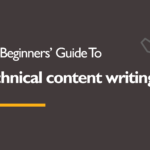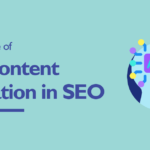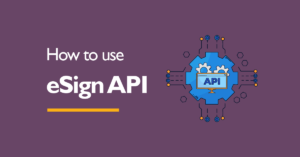For your brand to be seen and heard by the world’s biggest search engines, you must optimize technical content and website copy.
Search engines can index virtually anything published online (graphics, blog posts, images, and videos). However, for competitive queries, the content needs to rank highly for specific search terms.
As a content marketer, I understand that the best way to win search is to publish content around what people are searching for.
However, the relationship between creating quality content and achieving top SERPs can be difficult to understand.
Sometimes, technical help on your website is necessary to improve SEO, but in my experience, that’s not always the case.
In this blog, I’ll explore how to optimize technical content for search engines.
Different types of technical content optimization
On-page and off-page optimization emphasize content, keywords, and backlinks, while technical SEO addresses a website’s underlying technical aspects.
Without putting one over the other, your site will perform poorly if you’re not paying attention to content.
To increase business visibility and conversion rates, you must consider optimizing these key areas.
Landing page
A landing page is a webpage designed to convince users to pay for a product, sign up for a newsletter, or register for an event. It’s where potential customers land after clicking on an ad or a PPC campaign.
Creating a landing page is the easy part. But to get a landing page that converts, you need more than a written copy. HubSpot provides a variety of tools to help you generate copies and monitor the effectiveness of your landing page.
Landing page optimization involves enhancing your copy, visuals, and CTAs to increase engagement and generate more sales. The more optimized your landing page, the higher your organic search results will be.
Here are a few tricks to optimize your landing page right now:
- Craft a compelling headline.
- Offer data-driven insights to back your claims.
- Use bullet points to express product value.
- Include a short form to collect contact information.
- Insert bright, interactive images and graphics.
- Provide visitors with clear, simple next steps.
Technical documentation
Software documentation, user guides, product manuals, and other technical documents help developers, customers, and the general public understand how a product or service works.
Here are things to do in order to optimize technical documentation:
- Choose relevant long-tail keywords.
- Use descriptive headings and title tags.
- Write clear, instructive content.
- Follow a technical writing guide (Google has an excellent online guide).
If your documentation is not optimized for search engines, it may not reach its intended audience.
App store
App store optimization (ASO) is geared toward increasing an app’s visibility, downloads, and installs.
Since 82% of users discover apps through in-store recommendations and when browsing freely, do everything to keep your app at the top of the search results.

When advertising on Apple or Google Play, your app store optimization strategy should include these steps:
- Leverage keywords when crafting your app’s title and subtitle.
- Enter as many keywords as possible in the product description.
- Write a compelling app description.
- Use appealing visuals.
- Add all texts and captions to images and high-res screenshots.
- Ask for ratings and reviews.
Product Marketplace
An alternative way to boost sales is to optimize your product listings on marketplaces. With online stores, you get more face time with people who want to spend.
Yet, keep in mind that competition is usually stiff on Amazon, eBay, and even local marketplaces. Marketplace optimization (MPO) can help you navigate the mammoth crowd and put your products in front of millions of online shoppers.
Focus on optimizing these product categories: title, product description, reviews, and FAQs. Also, understand the place of featured listings and sponsored ads for driving content on leading marketplaces.
How to enhance technical content for SEO
Whether you’re writing from scratch or deploying AI content, it can be optimized to suit Google’s standards.
Here’s what you should do differently to optimize content for search engines, be visible to potential customers, and increase your sales opportunities.
Create fresh and relevant content
Content marketing is key to business growth. So, focus on creating evergreen content around what your prospects are searching for. All other SEO efforts will depend on your ability to write high-quality content.
Remember: You can’t outsmart Google. When someone opens a link, and it satisfies their search intent, they will stay on the page longer. If that happens, Google can deduce that your content is “helpful” and factor that into the ranking of your page.
Technology like PageRank provides algorithms that calculate the relevance of website content based on specific search queries. No one knows how this algorithm actually works.
If you want to stand out, focus on original, brand-specific content showing how users interact with your product. The authenticity of case studies, white papers, and customer testimonials encourages potential visitors to engage with your brand.
Use relevant keywords
Keywords are often overused or abused, thus the lack of results. The rise in zero-click searches due to featured snippets answering user queries demands more targeted research. Before you start writing, use Ahrefs, SEMrush, or any other AI tools to find product-related keywords.
When you practice keyword research, consider keywords based on their volume, difficulty, and intent. The higher the search volume, the more likely bloggers are to craft content around this keyword.
There are also keywords for which your site is already ranking. Use this data to inform your content strategy, whether to provide informational, commercial, or navigational blogs.
Optimize URLs and images
SEO-friendly URLs should be descriptive, readable, and keyword-inclusive.
For example, if the target keyword is “SEO basics”, the URL slug should look something like “xyz.com/seo-basics.”

With a properly formatted URL, you help search engines recognize the content and relevance of your pages. Readers can also figure out what the content is about before they open it.
You should also embed optimized URLs within your blogs and add keywords to alt texts and image captions.
Link to authoritative sources
External linking is one way to show Google that you’re experienced in what you’re writing about. When you strategically link to established websites in your niche, your website can increase its authority.
Linking allows you to practice Google’s E-A-T framework, which recognizes content with a high level of expertise, authority, and trustworthiness. You can get inbound links by reaching out to notable companies in your niche with significant traffic.
Take advantage of opportunities to insert internal links. This will allow users to experience other content on the website while creating a correlation map for the content on your website.
Update published content often
This is the most underrated and overlooked tip. Updating the published content regularly signals to Google that your website is active and relevant.
Updating published content also allows you to attract organic traffic and demonstrate authority in your niche. It also ensures you’re delivering accurate information so users know better to find you when seeking current data.
Especially if you write about trends, industry developments, and changing user needs, consider implementing a robust editorial calendar that allows you to revisit published content and retarget new keywords.
Fix errors from the Google Search Console
One of my favorite tools is Search Console, a free service offered by Google to help track your site’s position in search results. The Bing version is Webmaster Tools, and you need to register your website on these platforms for search engines to crawl it.

On Search Console, you can fix technical issues impacting the proper indexing of your web pages. These errors exist as blocked pages due to faulty XML sitemaps, incorrect robots.txt directives, and duplicate content.
Search engines typically prefer unique, properly canonized content. Therefore, for your web pages to be indexed and ranked, they must satisfy these requirements.
Optimize for voice search
A smart content optimization strategy involves thinking like the customer by optimizing your posts for voice search. Optimizing for voice queries allows you to appear when users ask Google Assistant or Apple’s Siri.

It involves adapting your web content to accommodate the nuances of spoken, natural language. Make sure to include long-tail keywords or relevant phrases that people are likely to search when they say “Hey Siri”.
I’ve also found that verbal searches are a popular tool for geo-specific queries, which can be helpful for local businesses seeking visibility.
Keep it short and concise
Lengthy posts are great, but it’s best to get straight to the point. You don’t want to bore readers where you could use fewer words.
SEMrush posits that a blog post should be about 1,500 to 2,000 words long. Many expert bloggers agree with this. However, there’s a unique sweet spot, depending on your niche.
With an ideal word count, you can address the topics in depth and offer valuable information that presents you as an authority. Brevity also presents better opportunities for backlinks, sharing on social media, etc.
Add close captions and subtitles to videos
Adding captions and subtitles to videos can enhance discoverability by clarifying the target keywords based on frequently searched phrases.

Captions also make video content more accessible, thus signaling to search engines that your site offers useful content. Once Google starts to pay attention to your site, it will positively affect search rankings.
Use on-page SEO tools
Well-written and readable content won’t automatically put you on the first page, but on-page optimization tools can elevate your chances.
With this SEO plugin, you can:
- Enter your focus keyphrase,
- Check readability scores,
- Optimize your snippet,
- Make your content inclusive,
- Make SEO adjustments to titles, headings, and subtitles.
Add the Yoast SEO plugin to your website and start using its features to optimize your pages and blog posts.
Make the content mobile-friendly
Most people use Google on their phones, so it’s crucial to ensure your website renders nicely on mobile devices.
For instance, you enter a URL into the Mobile-Friendly Test tool to assess your page’s responsiveness on mobile.

Google Search Console can also assist here by measuring if your entire website delivers a consistent user experience on mobile. For the non-technical part, break up the text into shorter, readable paragraphs so readers can follow easily.
Optimize technical content with an SEO expert
The goal is to keep SEO in mind without explicitly writing for search engines. Google punishes pages that try to exploit search engines without providing helpful content.
Ultimately delivering quality content and technical optimization remain the only path to the top of SERPs.
That’s why you should let the SEO experts at RoninPoint handle your technical and non-technical writing needs. Our professionals already have the tools and expertise to furnish your site with evergreen content.
With RoninPoint, you’ll receive high-grade content that propels your business to prominence and puts your products in front of potential clients while you focus on other high-value tasks. Contact us right away to get started with your custom technical content optimization.
Who wrote this?
Iruoma Chukwuemeka is a serial writer. She creates engaging content with best SEO practices for clients who need reliable hands on their writing projects. She's also got an appetite for information and books.
- Iruoma Chukwuemekahttps://roninpoint.com/author/iruomachukwuemeka/November 25, 2024
- Iruoma Chukwuemekahttps://roninpoint.com/author/iruomachukwuemeka/October 15, 2024
- Iruoma Chukwuemekahttps://roninpoint.com/author/iruomachukwuemeka/May 11, 2024
- Iruoma Chukwuemekahttps://roninpoint.com/author/iruomachukwuemeka/March 15, 2024









